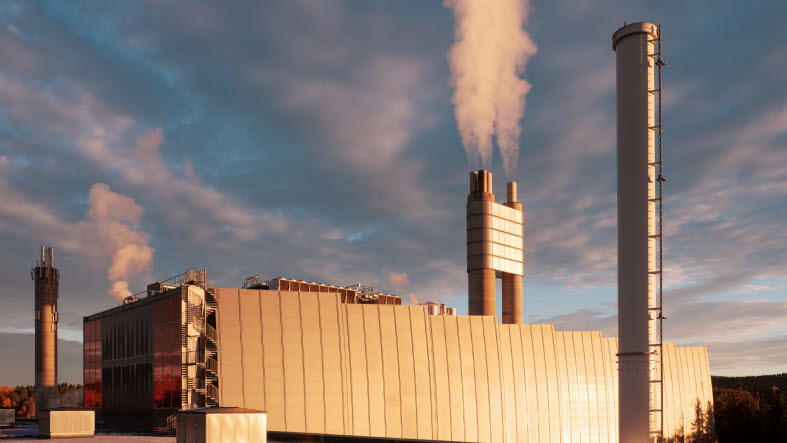Norway’s largest district heating network and waste incineration
Hafslund Celsio owns and operates Norway’s largest district heating network, which is in the greater Oslo region. The main source of heat is excess heat from waste incineration. Their own plant at Klemetsrud, on the outskirts of Oslo, is the country’s largest waste incineration plant and treats an estimated 350,000 metric tonnes of waste annually. The end treatment of waste creates carbon dioxide (CO2) emissions, both fossil and biogenic, of around 350,000 tonnes per year. The plant is the largest single source of fossil CO2 emissions in the municipality of Oslo, accounting for 17 per cent of the total.
To reduce emissions and meet Oslo’s ambitious climate goals, the company – with the support of the Norwegian state and the City of Oslo – is determined to establish a full-scale Carbon Capture and Storage (CCS) facility to capture and permanently store the carbon dioxide that the plant generates.
Longship and Northern Lights
Hafslund Celsio is, together with the cement manufacturer Heidelberg Materials, one of two capture plants in the Norwegian government’s initiative and demonstration project called Longship. Longship is Europe’s first complete, open value chain for CCS, including transport and permanent storage under the seabed in the North Sea by the Northern Lights project.
Northern Lights is a joint venture by the energy companies Equinor, Shell and TotalEnergies. Northern Lights has established a full-scale transport and storage solution and is ready to receive the first deliveries of liquid CO2 in 2024. Hafslund Celsio has secured capacity at Northern Lights, guaranteed by the Norwegian state, to store the carbon dioxide captured from the waste incineration process.
Hafslund Celsio will transport liquid CO2 by non-emission trucks to an intermediate storage facility at the Port of Oslo. The transport and storage operator Northern Lights will embark and load the captured CO2 before sailing to their facility at Øygarden on the west coast of Norway.
Biogenic carbon dioxide
Around half of the waste end treated at the waste incineration plant at Klemetsrud comes from biological sources, such as food scraps, paper, cardboard, and wood. The carbon dioxide emissions that occur when this waste is burned is biogenic and part of the natural carbon cycle. By capturing and storing these emissions, carbon dioxide is removed from the atmosphere, resulting in negative carbon emissions.
This is called Bio-CCS or BECCS, and the EU Commission, the UN, and the International Energy Agency all emphasise its great importance in reaching the world’s climate goals. The carbon removals volumes generated at Klemetsrud will be vigorously measured and scientifically verified by a third party.
Offers companies a way to reduce their carbon footprint
Hafslund Celsio now offers companies the opportunity to neutralize their climate footprint by acquiring carbon removal certificates. They correspond to a certain quantity of captured, biogenic CO2 delivered once the plant is operational, which is scheduled for 2028.
By opting in to purchase Carbon Dioxide Removal, or CDRs, from Hafslund Celsio’s project, the purchaser will be contributing to a positive final investment decision (FID).
At full capacity, the Klemetsrud facility will capture up to 175,000 tonnes of biogenic CO2 per year, in addition to reducing Oslo’s fossil emissions by 17 per cent.
“We offer a solution to companies that do not have the opportunity to reduce all their emissions. This concerns not only heavy industry sectors such as steel, energy, chemicals, cement, and aviation, but almost all sectors that have scope 3 emissions. By buying carbon removal certificates, they can neutralize their hard-to-abate emissions and thus reach their climate goals,” says Jannicke Gerner Bjerkås, director CCS and Carbon Markets at Hafslund Celsio.
Another essential driving force for the potential buyers may be to avoid future costs as the price increases in the European Emissions Trading System.
Emerging market
SEB has been mandated to sell Hafslund Celsio’s carbon removal certificates to a wide audience of prospective buyers. The bank is a pioneer in this emerging market and has previously received a similar mandate from the Norwegian project developer Inherit Carbon Solutions.
Maximilian Brodin, Head of Commodities at SEB, states that the market for carbon removals is still immature, but that it has many similarities to established commodity markets. He expects bio-CCS certificates to gradually evolve into liquid financial instruments.
“Hafslund Celsio is a flagship project in negative emissions, and we look forward to engaging in this partnership and showcasing the Oslo CCS-project to customers across Europe and elsewhere who are committed to an ambitious decarbonisation journey. Negative emissions will be an important part of their solution to cope with the most difficult last mile towards net zero,” he says.

